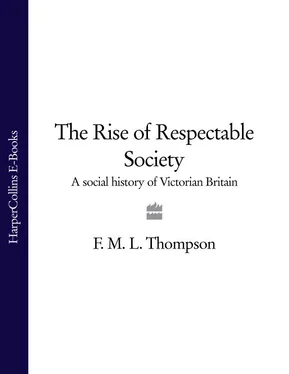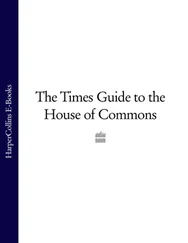The major shifts in the structure of the Victorian economy are only partially revealed by an approach through the occupations of the people, since that largely hides from view questions of international trade and investment, and assumes without discussion the different movements in productivity between sectors which were the essence of economic growth. The occupational results of economic changes, however, were the ones of most direct relevance to social structures and to individual lives. They suggest the complexity, diversity, and unevenness of the impact of the maturing industrial economy upon society, and indicate that continuity of the familiar was as important as change and disruption of work habits. They do not in themselves show how some uniformity and coordination was conjured out of occupational diversity, not only by the articulation of the different sectors into an effective economy, but also by common experience of expansion and depression, and these will be brought out later. Nor do they provide more than a partial explanation, or illustration, of the move to the towns, that other great social fact of the century. It is perfectly true that a restructuring of the kind observed, between agriculture and non-agriculture to put it at its most basic, had it been conceivable within a static population would have occasioned an increase in urbanization. The actual course of urbanization, however, the emergence of the large towns and the living conditions in them, were determined more by the pressure of increasing population than by industrialization. Increasing numbers migrated to the towns to escape from rural poverty and overpopulation; they went in greater numbers to the industrializing towns than to other towns, because job opportunities were better there, but they went to other towns as well. Increasing numbers, in turn, were only to a limited extent a response to industrialization; they were the result of fertility and mortality experiences within the basic population unit and social unit, the family.
The population of Britain entered on its prolonged and still continuing period of sustained growth from the middle of the eighteenth century. It built up to its fastest rate of increase between 1811 and 1821, after which the pace slackened somewhat although remaining at historically high levels, before it turned decisively downwards from 1881. This deceleration had little effect in the short run on the economy, because the age structure of the population and slight variations in the proportion that the active labour force formed of the total population, or activity rate, were sufficient to ensure that the size of the labour force continued to increase at much the same rate throughout the seventy years after 1831, and indeed until the 1920s. Similarly, the braking effects upon the growth of total population of the demographic changes plainly discernible from 1881 did not bite hard for a further generation; it was only after 1911 that population increase slowed to its typical twentieth-century level of 5 per cent or less per decade, having previously been at or above 10 per cent per decade ever since the first census. Nevertheless, although they might be ripples which barely affected the surface of population aggregates for another thirty years or more, the changes which surfaced in the vital statistics of the 1880s were of profound social significance. These concerned birth rates and fertility, and the prolonged decline in both, which began at this time and continued without interruption until after the Second World War, signalled the appearance of what were to become characteristic features of modern industrial societies: family limitation and small families.
Ever since Arthur Young observed that ‘the increase of employment will be found to raise men like mushrooms’ and that ‘it is employment that creates population: marriages are early and numerous in proportion to the amount of employment’, it has often been supposed that British population growth was a response to the expansion of manufacturing in the later eighteenth century and a perception that large families could become an economic asset through widening openings for child labour. This is to take an unjustifiably insular view, since the transition from the centuries-old demographic regime of very little long-term growth punctuated by sudden and violent fluctuations, to sustained increase, occurred at much the same time in most of north-western Europe and most notably in Ireland, rural areas with little or no increase in industrial activity, just as it did in Britain. The contrary and much more widely held view is that population growth was the result of a very general reduction in mortality brought about by increased agricultural productivity, improvements in nutrition, and a decline in plague and smallpox. While allowing that such factors may have had some influence, it now seems, however, that the key change was a decline in the age at marriage, with earlier marriages resulting in more children and larger families. The earlier marriages were a response to general improvements in material conditions and prospects, particularly in the price and availability of food, rather than to any increase of opportunities specifically in industry; and probably to the increasing irrelevance, outside peasant circles, of inheritance expectations as incentives to delayed marriage. With these qualifications, Arthur Young may not have been so far wrong.
The age of women at marriage continued to fall until the middle of the nineteenth century, but the decline was small and with the mean age remaining around twenty-five marriage could still be considered late, both in relation to puberty and to late twentieth-century habits, where twenty-two has become the average age at which women marry. Of more importance for trends in fertility and in total population, marriage was becoming more frequent and popular until the 1870s. Significant numbers never married, so that in 1881 12 per cent of the women aged forty-five to fifty-four, in England, and 19 per cent in Scotland, had never married; but the proportion remaining unmarried had declined, in every age group over the age of fifteen, since the first available figures, for 1851 (teenage marriages, however, were extremely uncommon, at only 2 or 3 per cent of the age group). It was primarily these marriage patterns which sustained the crude birth rate at around 35 per thousand of total population throughout the forty years after 1840, when the figures for births under the civil registration instituted in 1837 become reliable, and raised the fertility rate of births per thousand women in the childbearing age group of fifteen to forty-four, from 135 in the early 1840s to its peak of 156 in the mid-1870s. This increase in fertility was almost entirely due to increased nuptiality, rather than to any rise in the number of children per marriage.
From 1878 both the crude birth rate and the fertility rate entered upon their prolonged decline, and by 1901 were down to 28.5 and 114 in England (remaining slightly higher in Scotland), a drop of about 25 per cent from the peak rates. The start of the twentieth century did not, of course, mark any particular milestone in these trends, which continued on their downward course until more or less stabilized at new low levels reflecting the reproductive behaviour of late industrial or post-industrial society in the second half of the twentieth century. The social mechanisms producing these trends did, however, undergo a radical reversal, if not immediately after 1901 then after 1914, and this subsequent change was sufficiently radical to mark off the years between 1878 and 1914 (or, as these were the nearest census dates, between 1881 and 1911) as a highly distinctive phase in the marital behaviour of a fully industrialized society.
Читать дальше












